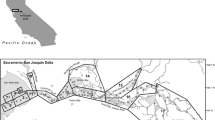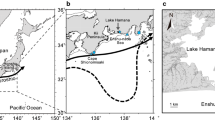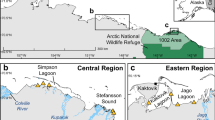Abstract
Resource development is increasing in northern Canada and with it comes the potential for a variety of impacts to aquatic environments (Birtwell et al. 2005; Cott et al. 2003), e.g., impacts from anthropogenic noise (Mann et al. 2009). Compared with what is known about aquatic environments in southern areas, there is a dearth of information on the ecology of fishes living in northern boreal environments (Birtwell et al. 2005). In the absence of northern-specific information, southern models are often used to assess environmental impacts of northern developments. Yet, northern and southern systems likely behave differently due to large differences in climate and productivity and therefore likely differ in their sensitivity to potential impacts. As such, unsuitable or incorrect resource management decisions may be made if northern-based information is not used.
Access provided by Autonomous University of Puebla. Download conference paper PDF
Similar content being viewed by others
Keywords
These keywords were added by machine and not by the authors. This process is experimental and the keywords may be updated as the learning algorithm improves.
1 Introduction
Resource development is increasing in northern Canada and with it comes the potential for a variety of impacts to aquatic environments (Birtwell et al. 2005; Cott et al. 2003), e.g., impacts from anthropogenic noise (Mann et al. 2009). Compared with what is known about aquatic environments in southern areas, there is a dearth of information on the ecology of fishes living in northern boreal environments (Birtwell et al. 2005). In the absence of northern-specific information, southern models are often used to assess environmental impacts of northern developments. Yet, northern and southern systems likely behave differently due to large differences in climate and productivity and therefore likely differ in their sensitivity to potential impacts. As such, unsuitable or incorrect resource management decisions may be made if northern-based information is not used.
Sound is important to fishes in several ways, such as in the detection of predators and prey, defense, courtship, and reproduction (Hawkins 1993). Since little is known about how fishes in boreal ecosystems use sound or the potential impacts anthropogenic sound may have on them, the assessments of noise-related impacts from northern developments may be difficult. The level of impact from disturbance is dependent not only on the proximity to and the type of sound source (Mann et al. 2009; Popper et al. 2005) but also on the physical environment, the life stage of the fish (Popper et al. 2005), and the life process the fish is undergoing at a specific point in time (e.g., spawning) (Finstad and Nordeide 2004).
Here we identify some sources of under-ice noise and their potential to disturb these fishes and describe what is known about the hearing of northern boreal fishes. Also, we present the potential for a widespread boreal piscivore, Lota lota (Burbot), to vocalize.
2 Under-Ice Noise
In northern Canada, the majority of industrial activity occurs during the winter when frozen waters and terrain allow access into remote areas. Activities are often conducted on ice (e.g., ice roads) over frozen lakes and rivers (Cott et al. 2008). Such activities generate sounds that can enter under-ice environments, changing the soundscapes of aquatic ecosystems and potentially disturb fishes (Mann et al. 2009). An assessment of noise generated from a diamond exploration camp was conducted in response to public and regulatory concern over the impacts of anthropogenic noise on fishes in ice-covered lakes. Sound from a variety of sources, typical of northern developments, was measured, including large- and small-diameter drills, ice road traffic and maintenance (trucks, graders), snowmobiles, aircraft (airplanes and helicopters), ice augers, ice chisels, walking, ice cracks, and ambient conditions. Although the natural under-ice soundscape is quiet (with the exception of ice cracks; peak sound pressure level [SPL] > 145 dB re 1 µPa), anthropogenic noise can be loud under ice (peak SPL 120–155 dB re 1 µPa depending on the source). Unlike ice cracks, which are intermittent and transient, anthropogenic noises are often persistent. Most sounds measured were within the hearing range of northern fishes (50–1,600 Hz), particularly by fishes with sensitive hearing such as Couesius plumbeus (lake chub) (Mann et al. 2007). However, away from the source, sounds that attenuate rapidly are not likely to cause physical harm to resident fishes (Mann et al. 2009).
3 Hearing of Boreal Fishes
Anthropogenic noise has been shown to impact the physiology (e.g., McCauley et al. 2003; Popper et al. 2005) and behavior (e.g., Finstad and Nordeide 2004; Hawkins 1993) of fishes. The effects of noise on fish can be correlated to the hearing sensitivity of the fish (e.g., Popper et al. 2005), making it important to understand the hearing capability of the fishes impacted at the life stages at which they may be. Recently, the hearing of eight species of northern boreal fish was assessed through auditory evoked potential of the lowest detectible sound using the auditory brain stem response technique. The research showed that the hearing sensitivity of fishes varied depending on the frequency investigated (Mann et al. 2007). In general, all species assessed had the most sensitive hearing at <400 Hz. Fish possessing Weberian ossicles, in this case, Couesius plumbeus and Catostomus catostomus (longnose sucker), had the most sensitive hearing and over the broadest frequency range (100–1,600 Hz). Cottus ricei (spoonhead sculpin) and Percopsis omiscomaycus (trout-perch) had sensitive hearing but in a narrow frequency range (>200 Hz) (Mann et al. 2007). Adult Esox lucius (northern pike) had more sensitive hearing than young-of-the-year Esox lucius (Popper et al. 2005), suggesting ontogenetic shifts in hearing ability.
4 Fish Vocalizations
Sound is central to the behavior of many animals including fishes, particularly in relation to reproduction (Hawkins 1993). Gadids are well represented among fishes that produce sounds. Gadus morhua (Atlantic cod) have been observed making “hum” or “grunt” sounds during spawning courtship (Finstad and Nordeide 2004; Hawkins 1993; Rowe and Hutchings 2006), and it has been suggested that their spawning vocalization is linked to spawning success (Rowe and Hutchings 2008). The mechanism by which Gadus morhua produce sounds is by movement of sonic muscles that are attached to their swim bladder (Hawkins, 1993; Rowe and Hutchings 2006; 2008). Lota lota, a close relative of Gadus morhua, also possess sonic musculature on their swim bladders (Hawkins 1993), which may enable them to vocalize.
Anthropogenic sounds may interfere with fish vocalizations, interfering with and masking their communication (Hawkins 1993). For instance, Finstad and Nordeide (2004) suggest that noise from commercial fishing activities may disturb spawning vocalizations and behavior of Gadus morhua. Such disruptions may interfere with mate selection, spawning success, or egg viability (Rowe and Hutchings 2006). Lota lota may be more sensitive to under-ice noise than other boreal fishes because they spawn under ice in the winter (Scott and Crossman 1973) when the majority of northern development occurs. The under-ice noise produced by industrial activities may disturb spawning Lota lota directly or may mask their prespawning vocalizations, reducing their ability to reproduce successfully.
To assess the potential for Lota lota vocalization, a pen net (10 m × 10 m × 10 m) dubbed “the Lota-tron” was positioned in Great Slave Lake, NWT, Canada, with the top of the Lota-tron frozen into the ice and anchored to the substrate. Adult prespawn Lota lota (n = 31) were collected in the vicinity and placed in the Lota-tron. An autonomous multichannel acoustic recorder (AMAR), capable of continuous recording of low-frequency sound (at levels produced by Gadus morhua), was deployed within the Lota-tron. The AMAR was deployed in mid-December 2009 and retrieved in mid-April 2010. This spanned the spawning period (mid-to-late February) for Lota lota in this location. These sound data are being analyzed for evidence of Lota lota vocalizations (P.A. Cott, unpublished observations).
5 Summary
There are many potential sources of anthropogenic noise that can manifest under ice in boreal lakes that are within the hearing ranges of northern boreal fishes. Impacts of noise on fish can be correlated to the fish’s hearing sensitivity. In general, boreal fishes have most sensitive hearing < 400 Hz, but this varies by species and life stage. By assessing the hearing capabilities and vocalizations of fish species and sound signatures from development activities, it may be possible to forecast potential impacts resulting from expected under-ice noise exposure.
There is still the need for basic information to facilitate the assessment and identification of potential impacts (e.g., the hearing capabilities of many species of boreal fishes at different life stages and the sound signatures of various anthropogenic noise sources). Additionally, the impacts to fish from a particular noise source (e.g., pile driving) or the potential for a sound-related disturbance at a particular time in a species life history, such as courtship or spawning, warrants further study.
References
Birtwell IK, Samis SC, Khan NY (2005) Commentary on the management of fish habitat in northern Canada: Information requirements and policy considerations regarding diamond, oil sands and placer mining – Summary Report. Canadian Technical Report of Fisheries and Aquatic Sciences 2607, Fisheries and Oceans Canada, West Vancouver, BC, Canada.
Cott PA, Hanna BW, Dahl JA (2003) Discussion on seismic exploration in the Northwest Territories 2000–2003. Canadian Manuscript Report for Fisheries and Aquatic Sciences 2648, Department of Fisheries and Oceans, Yellowknife, NWT, Canada.
Cott PA, Sibley P, Gordon A, Bodaly RA, Mills KH, Somers WM, Fillatre GA (2008) The effects of water withdrawal from ice-covered lakes on oxygen, temperature and fish. J Am Water Resour Assoc 44:328–342.
Finstad JL, Nordeide JT (2004) Acoustic repertoire of spawning cod, Gadus morhua. Environ Biol Fishes 70:427–433.
Hawkins AD (1993) Underwater sound and fish behaviour. In: Pitcher TJ (ed) Behaviour of teleost fishes, 2nd edn. Chapman & Hall, London, pp 129–169.
Mann D, Cott P, Horne B (2009) Under-ice noise generated from diamond exploration in a Canadian sub-arctic lake and potential impacts on fishes. J Acoust Soc Am 126:2215–2222.
Mann DA, Cott PA, Hanna BW, Popper AN (2007) Hearing in eight species of northern Canadian freshwater fishes. J Fish Biol 69:1–12.
McCauley RD, Fewtrell J, Popper AN (2003) High intensity anthropogenic sound damages fish ears. J Acoust Soc Am 113:638–642.
Popper AN, Smith ME, Cott PA, Hanna BW, MacGillivray AO, Austin ME, Mann DA (2005) Effects of exposure to seismic airgun use on hearing of three fish species. J Acoust Soc Am 117:3958–3971.
Rowe S, Hutchings JA (2006) Sound production by Atlantic cod during spawning. Trans Am Fish Soc 135:529–538.
Rowe S, Hutchings JA (2008) A link between sound producing musculature and mating success in Atlantic cod. J Fish Biol 72:500–511.
Scott WB, Crossman EJ (1973) Freshwater fishes of Canada. Fisheries Research Board of Canada Bulletin 184.
Author information
Authors and Affiliations
Corresponding author
Editor information
Editors and Affiliations
Rights and permissions
Copyright information
© 2012 Springer Science+Business Media, LLC
About this paper
Cite this paper
Cott, P.A., Mann, D.A., Higgs, D.M., Johnston, T.A., Gunn, J.M. (2012). Assessing Disturbance From Under-Ice Noise on Fishes in Boreal Lakes. In: Popper, A.N., Hawkins, A. (eds) The Effects of Noise on Aquatic Life. Advances in Experimental Medicine and Biology, vol 730. Springer, New York, NY. https://doi.org/10.1007/978-1-4419-7311-5_82
Download citation
DOI: https://doi.org/10.1007/978-1-4419-7311-5_82
Publisher Name: Springer, New York, NY
Print ISBN: 978-1-4419-7310-8
Online ISBN: 978-1-4419-7311-5
eBook Packages: Biomedical and Life SciencesBiomedical and Life Sciences (R0)




